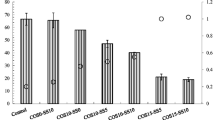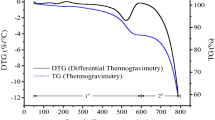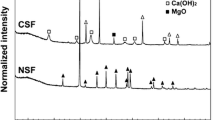Abstract
A novel treatment mix was designed for the simultaneous immobilization of As, Cu, and Pb in contaminated soils using natural (waste oyster shells (WOS)) and industrial (coal mine drainage sludge (CMDS)) waste materials. The treatments were conducted using the standard U.S. sieve size no. 20 (0.85 mm) calcined oyster shells (COS) and CMDS materials with a curing time of 1 and 28 days. The As immobilization treatments were evaluated using the 1-N HCl extraction fluid, whereas the Pb and Cu immobilization treatments were evaluated using the 0.1-N HCl extraction fluid based on the Korean leaching standards. The treatment results showed that the immobilization of As, Cu, and Pb was best achieved using a combination mix of 10 wt% COS and 10 wt% CMDS. This treatment mix was highly effective leading to superior leachability reductions for all three target contaminants (>93 % for As and >99 % for Cu and Pb) for a curing period of 28 days. The X-ray absorption near-edge structure (XANES) results showed that As was present in the form of As(V) in the control sample and that no changes in As speciation were observed following the COS-CMDS treatments. The scanning electron microscopy (SEM)-energy dispersive X-ray spectroscopy (EDX) sample treated with 10 wt% COS and 10 wt% CMDS indicated that As immobilization may be associated with the formation of Ca–As and Fe–As precipitates while Pb and Cu immobilization was most probably linked to calcium silicate hydrates (CSHs) and calcium aluminum hydrates (CAHs).






Similar content being viewed by others
References
American Society for Testing and Materials (ASTM) (2000) Annual Book of ASTM Standards, Soil and Rock, vol. 4.08
Ball DF (1964) Loss-on-ignition as an estimate of organic matter and organic carbon in non-calcareous soil. J Soil Sci 15:84–92
Chung IJ, Choi YS, Hong SW, Park HM (2001) Immobilization of arsenic in tailing by using iron and hydrogen peroxide. Environ Technol 22(7):831–835
Cui M, Na S, Khim J, Jang M (2012) Stabilizatin of heavy metal contaminated paddy soils (in Korean). J Korean Soc Hazard Mitigation 12(2):287–292
Dermatas D, Meng X (2003) Utilization of fly ash for stabilization/solidification of heavy metal contaminated soils. Eng Geol 70(3):377–394
Dermatas D, Menounou N, Dutko P, Dadachov M, Arienti P, Tsaneva V (2004) Lead and copper contamination in small arms firing ranges. Global NEST J 6(2):141–148
Drahota P, Filippi M (2009) Secondary arsenic minerals in the environment: a review. Environ Int 35:1243–1255
Dutré V, Vandecasteele C (1995) Solidification/stabilization of arsenic-containing waste; leach tests and behavior of arsenic in the leachate. Waste Manage 15(1):55–62
Dutré V, Vandecasteele C (1996) An evaluation of the solidification/stabilization of industrial arsenic containing waste using extraction and semi-dynamic leach tests. Waste Manage 16(7):625–631
Dutré V, Vandecasteele C (1998) Immobilizationmechanism of arsenic in waste solidified using cement and lime. Environ Sci Technol 32:2782–2787
FitzPatrick EA (1983) Soils: their formation, classification and distribution. Longman Science & Technical, London, p 353
Johnson CA (2002) Metal binding in the cement matrix: an overview of our current knowledge. Department of Water Resources and Drinking Water, Water-Rock Interaction Group, EAWAG, for Cemsuisse, Switzerland
Kim JY, Davis AP, Kim KW (2003) Stabilization of available arsenic in highly contaminated mine tailings using iron. Environ Sci Technol 37:189–195
Koo J, Song B, Kim H (2008) Characteristics of the release of chromium, copper, and arsenic from CCA-treated wood exposed to the natural environment. Anal Sci Technol 21(1):1–8
Kumpiene J, Lagerkvist A, Maurice C (2008) Stabilization of As, Cr, Cu, Pb and Zn in soil using amendments—a review. Waste Manage 28:215–225
Lee KC (2006) Immobilization characteristics of arsenic contaminated soil using soluble phosphate and arsenic coagulant. Master thesis, Sangmyung University, Republic of Korea
MDI (2005) Jade version 7.1. Material’s Data Inc, Livermore, California, USA
MOE (2002) The Korean Standard Test (KST) methods for soils (in Korean). Korean Ministry of Environment, Gwachun, Kyunggi
Moon DH, Dermatas D, Menounou N (2004) Arsenic immobilization by calcium-arsenic precipitates in lime treated soils. Sci Total Environ 330(1–3):171–185
Moon DH, Dermatas D, Grubb DG (2006) The effectiveness of quicklime-based stabilization/solidification on lead (Pb) contaminated soils, In: Environmental Geotechnics (5th ICEG), Thomas H.R. (ed.), Thomas Telford Publishing, London, 1, 221–228
Moon DH, Cheong KH, Khim J, Grubb DG, Ko I (2011a) Stabilization of Cu-contaminated army firing range soils using waste oyster shells. Environ Geochem Health 33:159–166
Moon DH, Kim KW, Yoon IH, Grubb DG, Shin DY, Cheong KH, Choi HI, Ok YS, Park JH (2011b) Stabilization of arsenic-contaminated mine tailings using natural and calcined oyster shells. Environ Earth Sci 64:597–605
Moon DH, Park J-W, Cheong KH, Hyun S, Koutsospyros A, Park J- H, Ok YS (2013) Stabilization of lead and copper contaminated firing range soil using calcined oyster shells and fly ash. Environ Geochem Health 35:705–714
Moon DH, Wazne M, Cheong KH, Chang Y-Y, Baek K, Ok YS, Park J-H (2015) Stabilization of As-, Pb-, and Cu-contaminated soil using calcined oyster shells and steel slag. Environ Sci Pollut Res 22:11162–11169
Moulin I, Stone WE, Sanz J, Bottero J-Y, Mosnier F, Haehnel C (1999) Lead and zinc retention during hydration of tri-calcium silicate: a study by sorption isotherms and 29Si nuclear magnetic resonance spectroscopy. Langmuir 15:2829–2835
Pantsar-Kallio M, Manninen PKG (1997) Speciation of mobile arsenic in soil samples as a function of pH. Sci Total Environ 204:193–200
Qiao XC, Poon CS, Cheeseman CR (2007) Investigation into the stabilization/solidification performance of Portland cement through cement clinker phases. J Hazard Mater B139:238–243
Rose J, Moulin I, Hazemann J-L, Masion A, Bertsch PM, Bottero J-Y, Mosnier F, Haehnel C (2000) X-ray absorption spectroscopy study of immobilization processes for heavy metals in calcium silicate hydrates: 1. Case of lead. Langmuir 16:9900–9906
Sims R, Sorenson D, Sims J, McLean J, Mahmood R, Dupont R, Jurinak J, Wagner K (1986) Contaminated surface soils in-place treatment techniques. Noyes Publications, Park Ridge, NJ
Stronach SA, Walker NL, Macphee DE, Glasser FP (1997) Reactions between cement and As(III) oxide: the system CaO-SiO2-As2O3-H2O at 25 °C. Waste Manage 17(1):9–13
Wilopo W, Sasaki K, Hirajima T, Yamanaka T (2008) Immobilization of arsenic and manganese in contaminated groundwater by permeable reactive barriers using zero valent iron and sheep manure. Mater Trans 49(10):2265–2274
Acknowledgments
This study was supported by the Korean Ministry of Environment as the GAIA (Geo-Advanced Innovative Action) project (no. 2014000540011). The authors would like to thank the members of Pohang Accelerator Laboratory (PAL), Republic of Korea for their integral help with XANES analyses.
Author information
Authors and Affiliations
Corresponding author
Additional information
Responsible editor: Zhihong Xu
Rights and permissions
About this article
Cite this article
Moon, D.H., Cheong, K.H., Koutsospyros, A. et al. Assessment of waste oyster shells and coal mine drainage sludge for the stabilization of As-, Pb-, and Cu-contaminated soil. Environ Sci Pollut Res 23, 2362–2370 (2016). https://doi.org/10.1007/s11356-015-5456-9
Received:
Accepted:
Published:
Issue Date:
DOI: https://doi.org/10.1007/s11356-015-5456-9




